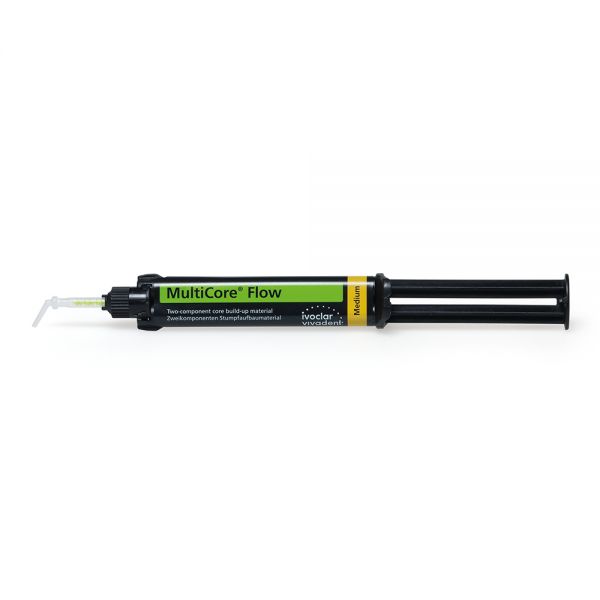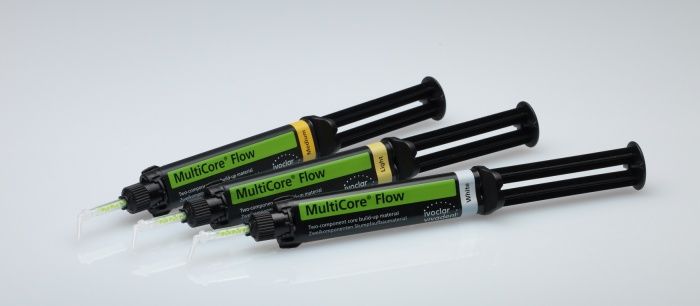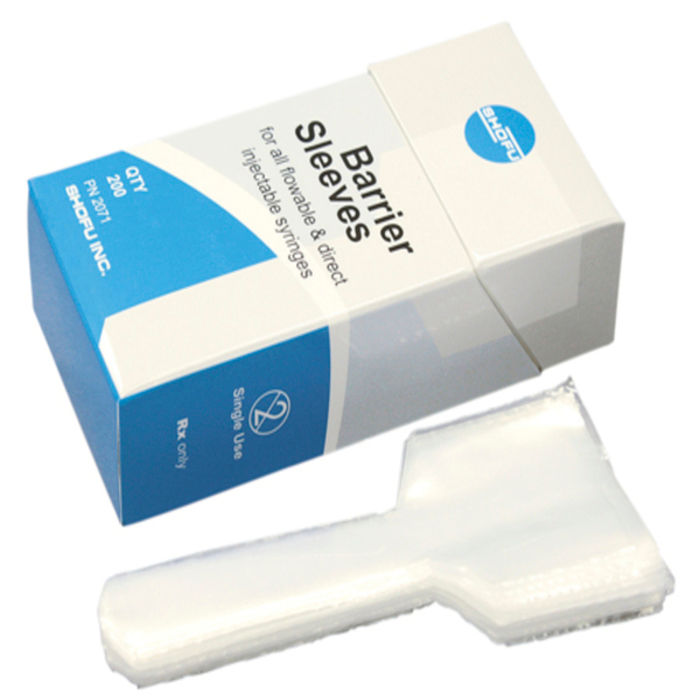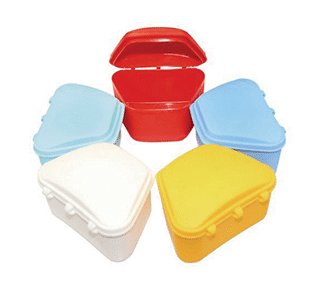Ivoclar Multicore Flow 3.5g Shade Medium
Core Build Up Material
$18.31 $23.76
MultiCore Flow is a dual-curing, fluoride-containing, radiopaque composite for core build-ups. It cures chemically without the use of light. Light-curing is optional. MultiCore Flow is available in a double-barrel cartridge or a double-push syringe with automixing tips for fabricating core build-ups using matrices.
The self-curing MultiCore core build-up composite, which may be optionally light cured, brings flexibility to your dental practice.
Two techniques, two curing methods and four shades provide an optimum foundation for the reconstruction of vital and non-vital teeth with part or most of the clinical crown missing.
COMPOSITION:
- The monomer matrix consists of dimethacrylate (29 wt %)
- The inorganic fillers are barium glass, ytterbiumtrifluoride, Ba-Al-fluorosilicate glass and highly dispersed silicon dioxide (70 wt %)
- Additional contents are catalysts, stabilizers and pigments (1 wt %). The total content of inorganic fillers is 46 vol %. The particle size ranges from 0.04 to 25 µm
INDICATIONS:
- Core build-up in vital and non-vital teeth
- MultiCore Flow can also be used for the adhesive cementation of glass-fibre reinforced root posts, e.g. FRC Postec Plus.
Specifications
| Weight | 0.1 kg |
|---|---|
| Brands |
TECHNICAL SPECIFICATIONS:
Working time: 90 to 120 s (at 37°C/98.6°F)
Mixing ratio: The base and catalyst pastes of MultiCore Flow are mixed at a ratio of 1:1.
MultiCore Flow is mixed by pressing the pastes through the static mixing tip
INTERACTIONS:
- Substances containing eugenol/oil of cloves may inhibit the polymerization of composite materials. Consequently, application of such materials together with MultiCore Flow must be avoided
PRECAUTIONS:
- MultiCore Flow should be at room temperature when processed. At lower temperatures (e.g. immediately after removal from the refrigerator) it may be difficult to extrude the material.
Packaging
Direction to use
DIRECTIONS TO USE IN SIMPLE STEPS:
STEP 1: Preoperative situation
STEP 2: Placement of the matrix
STEP 3: Application of Adhese Universal and subsequent polymerization
- STEP 4: Application of MultiCore Flow
- STEP 5: Polymerization with Bluephase Style
- STEP 6: Completed core build-up
DIRECTIONS TO USE IN BRIEF:
I. Fabrication of a reconstructive build-up
Apply a dentin bonding agent to the clean dentin surfaces. Ivoclar Vivadent recommends using either Adhese® Universal, Syntac® or ExciTE® F as the bonding agent when MultiCore Flow is used in the light-cure mode. If no light is used, the application of a dual-curing adhesive, e.g. ExciTE F DSC, is recommended. These Instructions describe the procedure with Adhese Universal.
Please refer to the instructions of the respective bonding agents for further information
- Isolation A dry operating field must be ensured. Ideally, a rubber dam should be used (e.g. OptraDam® Plus)
- Pulp protection / Base In very deep cavities, areas close to the pulp should be selectively coated with a calcium hydroxide liner (e.g. ApexCal®) and subsequently covered with pressure-resistant cement (glass ionomer cement, e.g. Vivaglass® Liner)
- Conditioning with phosphoric acid gel (optional) Apply phosphoric acid gel (e.g. Total Etch) to the prepared enamel and then flow the etchant onto the prepared dentin. The etchant should be left to react on the enamel for 15–30 s and on the dentin for 10–15 s. Then rinse thoroughly with a vigorous stream of water for at least 5 s and dry with compressed air until the etched enamel surfaces appear chalky white
- Application of the adhesive – Starting with the enamel, thoroughly coat the tooth surfaces to be treated with Adhese Universal.
- The adhesive must be scrubbed into the tooth surface for at least 20 s. This time must not be shortened. Applying the adhesive on the tooth surface without scrubbing is inadequate
- Disperse Adhese Universal with oil- and moisture-free compressed air until a glossy, immobile film layer results
- Light-cure Adhese Universal for 10 s using a light intensity of ≥500 mW/cm²
- Contamination by blood or saliva must be avoided after the application of the bonding agent
Insertion of the cartridge:
- Remove the sealing cap by turning it 1/4 turn counter clockwise
- It is very important to clear or bleed the cartridge or syringe prior to applying the mixing tip. Gently press the dispenser lever until both components (base and catalyst) begin to flow out evenly onto a mixing pad
- For each application, place a new mixing tip on the cartridge/syringe. Push the tip completely down until the notch of the mixing tip is aligned with the notch on the housing of the cartridge/syringe. Secure the mixing tip in place by gripping the coloured base, and not the mixing tip, and by turning it 1/4 turn clockwise (Fig. 3). As MultiCore Flow will cure in the used mixing tip, it may serve as a seal for the contents of the cartridge/syringe until needed once again (replace with a new tip just before the next use)
- If necessary apply an intra-oral tip to the mixing tip (Fig. 4). Larger amounts of material can be extruded if the intra-oral tip is shortened by approx. 1 mm
Application of MultiCore Flow
- Place matrix band around the prepared tooth
- Apply MultiCore Flow directly to the cavity with the intra-oral tip in place
- If no light is used, wait for 4–5 minutes until the chemical curing process is complete before removing the matrix. If the material is light-cured, it may be ground immediately after completing the curing cycle
- Optionally, MultiCore Flow may be cured from the occlusal for approx. 10 s (approx. 1,100 mW/cm², e.g. Bluephase Style) ensuring a minimal distance between the light emission window and the build-up. Remove the matrix band. If necessary, cure incompletely polymerized areas for another 10 s
- Use rotary instruments to complete the crown preparation
II. Adhesive cementation of endodontic posts made of fibre-reinforced composite and core build-ups
1. Pretreatment of the root canal and the coronal dentin
A dry operating field must be ensured. Ideally, a rubber dam should be used, e.g. OptraDam Plus
Prior to cementing endodontic posts, clean the root canal thoroughly to remove any residue of root canal sealers (Residue of eugenol-based sealers may inhibit the polymerization of the luting composite)
- Condition the root canal, the coronal dentin and the enamel surfaces according to the instructions of the manufacturer of the dentin bonding agent used (eg or ExciTE F DSC)
- After applying the dentin bonding agent, make sure to remove all excess material from the root canal using paper points
- Do not light-cure the bonding agent. – Place matrix band around the tooth
2. Adhesive cementation
- Clean and condition post surface according to the manufacturer‘s instructions
- Coat the endodontic post, which has been prepared according to the instructions of the post manufacturer, with the mixed MultiCore Flow. Additionally, MultiCore Flow may be applied to the root canal by means of the Intra Canal Tips. It is not recommended to use a lentulo spiral for loading MultiCore Flow into the root canal, as this will lead to the intermixing of bonding agent excess and MultiCore Flow. As a result, the working time of MultiCore Flow will be reduced, so that it may be impossible to push the post into the desired position within the root canal
- Excess cement will be displaced when the post is inserted
- Distribute excess cement across the occlusal preparation surface for total coverage
- Subsequently, light-cure MultiCore Flow for 20 s (at a light intensity of approx. 1,100 mW/cm², e.g. Bluephase Style). In the process, hold the post in position with the curing light. If non-translucent, opaque endodontic posts are cemented, wait for the self-curing mechanism to take effect.
Features
Practical automix tip :
- The automix tip and the intraoral tip ensure excellent mixing of the contents and precise application. MultiCore Flow adapts very well to dentin surfaces that have been pre-treated with bonding agent, and it generates a strong bond to the remaining dental hard tissue
Self-curing or light-curing:
- MultiCore is a self-curing composite resin (curing time 4 to 5 min). The curing time can be significantly reduced (20 s per surface) by light-curing the material with a polymerization device, e.g. Bluephase® Style. Therefore, the material can also be placed in one bulk increment
Different shades:
- The MultiCore range comprises the shades light, medium, white and blue. As a result, a sound base can be created for all types of prosthetic crowns – be they metal, veneered or all-ceramic.
- A suitable consistency for every technique:
- MultiCore HB for the moulding technique
- MultiCore Flow for the matrix technique
- Based on Ivoclar Vivadent‘s long-term experience in the field of composite technology
- A suitable option for every case: Self- or light-curing
- Coordinated system with the self-etching Adhesive.














There are no reviews yet.